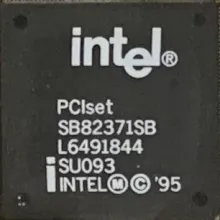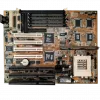
The Intel SB82371SB, also known as the Intel South Bridge 82371SB, is an older chipset component commonly used in conjunction with Intel's 486 and early Pentium processors. As a South Bridge chipset, its primary role was to manage I/O (input/output) functions and peripheral connectivity for the computer system. Here are some key details about the Intel SB82371SB chipset:
-
486 and Early Pentium Compatibility: The SB82371SB chipset was designed to work with Intel 486-class processors and early Pentium processors. It played a crucial role in powering systems during the transition from 486 to Pentium CPUs.
-
I/O Controller: The primary function of the SB82371SB was to act as an I/O controller. It managed various input and output functions, including interfacing with peripherals like hard drives, floppy drives, keyboards, and serial and parallel ports.
-
IDE Support: The chipset included support for IDE (Integrated Drive Electronics) interfaces, allowing for the connection of hard drives and CD-ROM drives. This was a significant advancement at the time.
-
Legacy Ports: It supported legacy ports such as RS-232 serial ports and parallel ports for connecting printers and other external devices.
-
ISA Slots: Motherboards featuring the SB82371SB chipset often included ISA (Industry Standard Architecture) expansion slots for compatibility with older expansion cards.
-
Obsolescence: Like many older chipsets, the SB82371SB has become obsolete as technology has advanced. It was replaced by more modern chipsets that offered greater performance and functionality.
The Intel SB82371SB chipset played a vital role in the development of personal computing during the late 1980s and early 1990s. It provided the necessary I/O control and compatibility features for computers of that era, contributing to the growth of the PC industry. However, it is now considered a relic of computing history, as it has been replaced by more advanced chipsets in modern computers.
